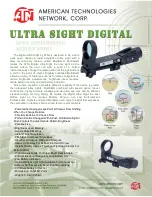
8
Polar Alignment
For Northern Hemisphere observers, approximate polar align-
ment is achieved by pointing the mount’s right ascension axis
at the North Star, or Polaris. It lies within 1° of the north celes-
tial pole (NCP), which is an extension of the Earth’s rotational
axis out into space. Stars in the Northern Hemisphere appear
to revolve around the NCP.
To find Polaris in the sky, look north and locate the pattern of
the Big Dipper (Figure 8). The two stars at the end of the
“bowl” of the Big Dipper point right to Polaris.
Observers in the Southern Hemisphere aren’t so fortunate to
have a bright star so near the south celestial pole (SCP). The
star Sigma Octantis lies about 1° from the SCP, but it is barely
visible with the naked eye (magnitude 5.5).
For general visual observation, an approximate polar align-
ment is sufficient.
1. Level the equatorial mount by adjusting the length of the
three tripod legs. Temporarily remove the optical tube and
counterweights from the mount before attempting to do this.
2. There are two altitude adjusting L-bolts (see Figure 7);
loosen one while tightening the other. By doing this you will
adjust the latitude of the mount. Continue adjusting the
mount until the pointer on the latitude scale is set at the lat-
itude of your observing site. If you don’t know your latitude,
consult a geographical atlas to find it. For example, if your
latitude is 35° North, set the pointer to 35. The latitude set-
ting should not have to be adjusted again unless you move
to a different viewing location some distance away.
3. Loosen the Dec. lock lever and rotate the telescope’s opti-
cal tube until it is parallel with the right ascension axis, as
it is in Figure 7.
4. Move the tripod so the telescope tube and right ascension
axis point roughly at Polaris. If you cannot see Polaris
directly from your observing site, consult a compass and
rotate the tripod so the telescope points north.
The equatorial mount is now polar aligned for casual observing.
More precise polar alignment is recommended for astrophotog-
raphy. For this we recommend using the polar axis finder scope
From this point on in your observing session, you should not
make any further adjustments to the latitude of the mount, nor
should you move the tripod. Doing so will undo the polar align-
ment. The telescope should be moved only about its R.A. and
Dec. axes.
Using the Polar Axis Finder Scope
The Atlas EQ mount comes with a polar axis finder scope
(Figure 9) housed inside the right ascension axis of the
mount. When properly aligned and used, it makes accurate
polar alignment quick and easy to do.
Alignment of the Polar Axis Finder Scope
1. Loosen the Dec. lock lever and rotate the optical tube on
the declination axis so that the tube is at a 90° to the right
ascension axis (Figure 10). Tighten the Dec. lock lever.
2. Look through the polar finder at a distant object (during the
day) and center it in the crosshairs. You may need to adjust
the latitude adjustment L-bolts and the tripod position to do
this.
3. Rotate the mount 180° about the R.A. axis. Again, it may
be convenient to remove the counterweights and optical
tube first.
4. Look through the polar finder again. Is the object being
viewed still centered on the crosshairs? If it is, then no fur-
ther adjustment is necessary. If not, then look through the
polar finder while rotating the mount about the R.A. axis.
You will notice that the object you have previously centered
moves in a circular path. Use the three alignment
setscrews on the polar axis finder (Figure 9) to redirect the
crosshairs of the polar finder to the apparent center of this
circular path. Repeat this procedure until the position that
the crosshairs point to does not rotate off-center when the
mount is rotated in R.A.
The polar axis finder scope is now ready to be used. When not
in use, replace the plastic protective cover to prevent the polar
finder from getting bumped.
Using the Polar Axis Finder Scope
The reticle of the polar axis finder scope for the Atlas has a
tiny star map printed on it that makes precise polar alignment
Figure 9.
The optional polar axis finder scope.
Eyepiece
focus ring
Alignment
setscrew (3)
Focus
lock ring
Objective
lens
Figure 8.
To find Polaris in the night sky, look north and find the
Big Dipper. Extend an imaginary line from the two “Pointer Stars” in
the bowl of the Big Dipper. Go about five times the distance between
those stars and you'll reach Polaris, which lies within 1° of the north
celestial pole (NCP).
Big Dipper
(in Ursa Major)
Little Dipper
(in Ursa Minor)
Cassiopeia
N.C.P.
Pointer
Stars
Polaris































